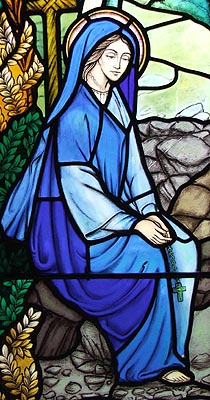 |
 |
|||
|
|
Gwenfrewy, more commonly called Winifred, was a descendant of the early Kings of Powys and the daughter of Tyfid, a great and rich man in North Wales: Lord of the townships of Abeluyc (Trefynnon alias Holywell), Maenwen & Gwenffynnon in Tegeingl. After being harassed by some young princes of Powys, her maternal uncle, St. Beuno, decided to move home with his family and offered to become Winifred's teacher in return for some land on which to build a church. Tyfid gave him Abeluyc and here, in the steep Valley of Sechnant, Beuno set up house. Daily, he instructed Winifred in the little church he had built and, eventually, gave her the religious veil, with the approval of her father and mother. One day, Winifred's parents and their servants were all at church, Beuno was officiating, and Winifred was left alone in the house. While they were out, Caradog, son of Prince Alaog, Lord of Pennarlag (Hawarden alias Pennard Halawg) rode by and stopped at the house to ask for a drink. He was so overcome by Winifred's beauty, that he made improper suggestions and, when rejected, moved to force himself upon her. Winifred fled to join her family at Abeluyc. The young horseman easily overtook her, however, and, in a fit of rage, cut off her head on the steps of the church (22nd June). Caradog stood with his sword in his hand, unable either to stir from the spot or to repent. At all the commotion, St. Beuno came rushing outside. Distraught, he cursed the young prince for his terrible crime, who immediately dropped down dead and was whisked away by devils. Beuno informed the assembled Christians that Winifred had vowed to die a martyr to her virginity and Christianity. Then he took up her head from the ground and set it back in its rightful place. From where it had fallen, there instantly sprang up a well of pure clear water. At the same time, he commanded the congregation to pray that Winifred might be restored to life and fulfil her vow; and, when they arose from praying, she arose with them. For the rest of her life she had a red mark round her throat where it had been sliced through. By Beuno's advice, Winifred remained at that church, gathering around her eleven virgins of honest and holy conversation and instructing them in the Christian religion. Beuno himself travelled west, first to Ireland; but Winifred and her maidens worked him a chasuble or some pretty piece of needlework every year. They put it into their well and the stream always carried it safely to him. After travelling, on a pilgrimage, to Rome, Winifred called together the 'Synod of Winifred,' attended by most of the holy men and women of Wales, Dumnonia and the North. Here it was agreed that her initiative of living a religious life in grouped safety was preferable to that of the hermitage; and, having been at Abeluyc for seven years, she decided to move on and help create such establishments elsewhere. She travelled to Bodfari, but the hermit, St. Diheufyr, was not interested in her new ideas. Similarly with St. Sadwrn at Henllan. It was not until she reached Gwytherin that she was welcomed by her mother's cousin, St. Eleri. Here, Winifred was presented to his mother, St. Tenoi, and together they established a double monastery in the village. Winifred eventually succeeded the latter as abbess there and, upon her death on 3rd November AD 660, she was buried in the monastic cemetery by her sponsor. St. Winifred was a local Welsh saint of little importance until her relics were translated, in 1136, to a magnificent shrine in Shrewsbury Abbey; and her popular Life was written by Prior Robert of Shrewsbury only two years later. Her original tomb was retained at Gwytherin and St. Winifred's Well, still to be seen in the old town of Holywell in Flintshire, became - and remains - one of the most visited shrines in the whole of Wales. It is fed by a stream of singular brightness, unfortunately not the original, but from the same source. The temperature of the water never changes, summer or winter. It is so clear that the pebbles at the bottom are distinctly seen to be stained as though with blood. The copious supply is never affected by the longest drought or the heaviest rains and miraculous cures, apparently, continue to occur there. It is lined with fragrant moss, the Jungermannia oplevoides. The beautiful chapel which stands over it was built by the Countess of Richmond, mother of King Henry VII, but is earlier in origin. Partly edited from Agnes Dunbar's "A Dictionary of Saintly Women" (1904). Records of St. Winifred date back to the 12th century. She is generally considered legendary.
|
|||
| © Nash Ford Publishing 2001. All Rights Reserved. | ||||





 St. Gwenfrewy alias Winifred,
St. Gwenfrewy alias Winifred,